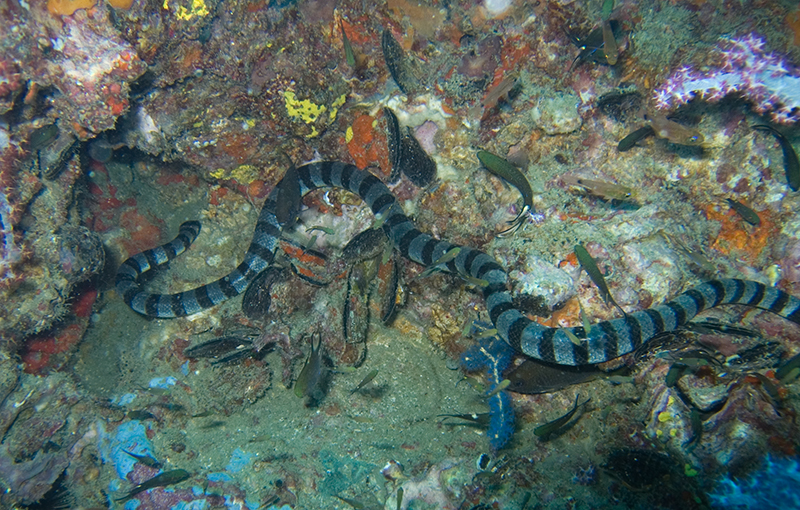The 60+ species of sea snakes – brightly colored, highly venomous relatives of the cobras, mambas and coral snakes – are little studied and not often seen in zoos. I was fortunate enough to have worked with yellow-bellied sea snakes (Pelamis platurus) at the Bronx Zoo, but the species is no longer exhibited there (perhaps something to do with the preferred diet of live moray and American eels?). If you have the opportunity to visit a zoo that keeps sea snakes, by all means do so – you will not be disappointed.
How Marine Snakes Find Fresh Water
A recent Physiological and Biochemical Zoology article, written by noted herpetologist Harvey Lillywhite, dispels a popular belief concerning marine snakes. Sea snakes, it seems, do not use special glands to extract salt from sea water, thus rendering it drinkable. These glands remove excess salt from the bloodstream, but the snakes can drink only fresh or very dilute sea water.
 Research focusing on the black-banded sea krait (Laticauda semifasciata) showed that the snakes obtain all their drinking water from fresh water springs (sea kraits leave the water on occasion), and refuse to drink sea water even when dehydrated. The majority of other sea snakes, which do not travel overland, are presumed to drink from the surface layer of fresh water that develops on the ocean when it rains. Indeed, sea snakes reach their greatest diversity in regions with heavy rainfall, and sea kraits are most common near fresh water spring outflows.
Research focusing on the black-banded sea krait (Laticauda semifasciata) showed that the snakes obtain all their drinking water from fresh water springs (sea kraits leave the water on occasion), and refuse to drink sea water even when dehydrated. The majority of other sea snakes, which do not travel overland, are presumed to drink from the surface layer of fresh water that develops on the ocean when it rains. Indeed, sea snakes reach their greatest diversity in regions with heavy rainfall, and sea kraits are most common near fresh water spring outflows.
Notes on Marine Reptiles in North America
The study seems to raise questions as to the drinking habits of other marine reptiles, such as sea turtles. It brought to my mind time spent observing mangrove salt marsh snakes (Nerodia clarkii compressicauda) in Florida – that particular snake lives largely in salt water, but periodically travels to nearby fresh water swamps to drink.
At the mouth of the Nissequogue River on Long Island, NY, I encountered a population of snapping turtles (Chelydra serpentina) that have been documented as having salt-excreting glands not possessed by snapping turtles living further upstream in the same river. I’ll soon review an article written on the turtles in that habitat, with a view towards reconciling it with this surprising new information.
You can read more about the natural history of sea snakes and sea kraits at the web site of the Chicago Field Museum:
http://www.fieldmuseum.org/aquaticsnakes/true_sea.html
Image referenced at Wikipedia, http://en.wikipedia.org/wiki/Image:Banded_Sea_Snake-jonhanson.jpg, and originally posted by Jon Hanson on FlickR.
 That Reptile Blog – Reptile, Amphibian and Exotic Pet Care and Information
That Reptile Blog – Reptile, Amphibian and Exotic Pet Care and Information


